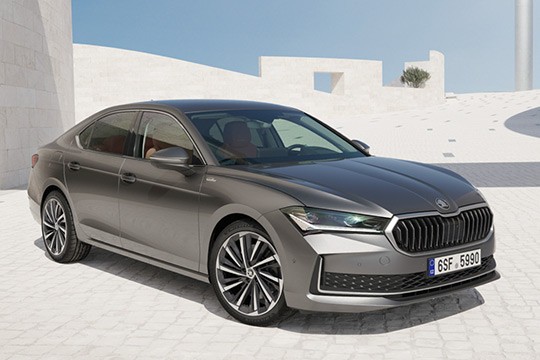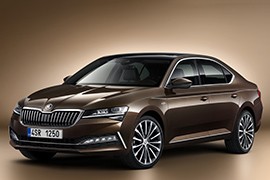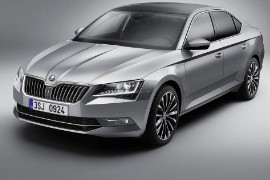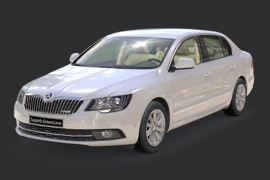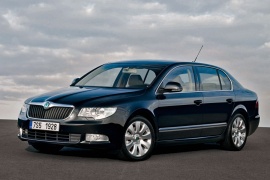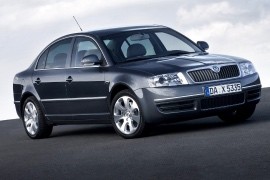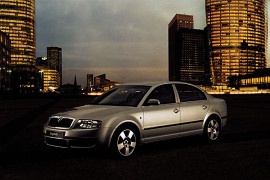SKODA Superb Models/Series Timeline, Specifications & Photos
First production year: 2002
Engines: Gasoline, Diesel, Hybrid
Škoda introduced the fourth generation of its flagship sedan, the Superb, in late 2023 for the 2024 model year, continuing its presence in the European midsize-sedan segment.
Škoda introduced the Superb nameplate in the 30s, but after WWII, in 1949, the model was withdrawn from the assembly lines. The country needed affordable cars, not expensive and luxurious vehicles powered by V8 gasoline engines. But the nameplate remained in Škoda's inventory, and after Volkswagen bought the Czech automaker, it considered introducing it. That didn't happen until 2001 when it used a long-wheelbase platform of the Volkswagen Passat and created the new Superb.
It was an immense success. Not only was the vehicle more comfortable than its shorter German sibling, but it also came with some unique features unseen on budget-friendly cars, such as umbrellas in the rear doors. By 2023, the Superb reached its fourth generation, and just like the second and third generations, it was available in two shapes: sedan and station wagon.
The Czech car manufacturer continued to pen its vehicles in the cubist design language. As a result, at first sight, the 2024 Superb looked like a larger Škoda Octavia, its smaller sibling. And yet, there were significant differences other than the longer wheelbase. At the front, the sharp lines of the headlights featured two LED blocks inside them for high and low beams, underlined by the daytime running light strips that were also used for turn signals.
The main element of the front fascia was the upper grille, which dominated it with its chromed vertical slats and octagonal shape, where the upper middle section was pinched down. Still, there were no curved lines here either. The lower bumper, on the other hand, sported a second air intake rounded towards the outer sides and featured a diamond-pattern mesh trim. From its profile, the Superb kept its ascending waistline from the previous generation, with an up-kick towards the ends of the rear doors. Finally, the back of the vehicle sported a sloped window and a short deck. On the rear fascia, the taillights' shapes mimicked those of the headlights, a design theme carried over from the Superb's second generation. Last but not least, despite looking like a sedan, the car was actually a hatchback, with its tailgate shaped in two steps: the window and the trunk lid.
Inside, customers found an elegant cabin packed with up-to-date technologies, such as a 10" Virtual Cockpit (digital instrument cluster) and a 13" touchscreen placed atop the center stack in a free-floating position. Below this, the automaker installed three digital dials that included small displays with a haptic feedback feature.
As a result, all of them could control various functions depending on how they were rotated, swiped, or touched. The long wheelbase of the vehicle helped with the legroom for the rear-seated passengers, so there was no problem fitting three adults on the split-folding bench seat.
Under its hood, the fourth generation of the Superb offered customers a wide choice of engines that included a mild-hybrid, a plug-in hybrid, three gasoline powerplants, and two turbo-diesel units. All versions were paired with DSG automatic (dual-clutch) transmissions, and the most potent versions were fitted with traction on all corners.
The Czech brand's flagship model is called the Superb. Its 2019 facelift brought new technologies and more refinement to the 4.9m (6 ft) long car. The Superb is available either as a sedan or a station wagon and it is available with engines starting from a 1.6-liter turbodiesel up to a 2.0-liter gasoline-powered four-cylinder or a 1.4-liter PHEV.
On the outside, the 2019 Superb may be noticed by its full Matrix-LED Headlights installed as standard on the whole range. The front bumper has been extended for better aerodynamic integration and sleeker styling. For the top-version, called Laurin&Klement, Skoda installed new esthetic chromed details around the headlights, side sills, front and rear bumpers.
For the station wagon version, the Superb offers a much bigger trunk space. If the sedan can carry between 625 to 1760-liters (22-62 cu-ft), the two-box variant offers 660 to 1960-liters (23-69 cu-ft).
The base model has a 1.6-liter turbodiesel engine with 120 hp. Other engines are a 2.0-liter turbodiesel or turbo-gasoline with 150, 190 or 272 hp, respectively. The PHEV version has a 1.4 TSI (turbo-gasoline) engine and an electric motor with a combined power output of 218 hp and 400 Nm (295 lb-ft) of torque. The average fuel consumption for the plug-in hybrid under WLTP norms is 1.4 l/100 km (201.7 mpg-UK).
Skoda introduced the third generation of its flagship model, the Superb, in 2015, and it was available either as a station wagon or a sedan.
Volkswagen Group was good at creating more vehicles based on the same MQB platform, which was also used for the Golf and many other vehicles built under the automaker's umbrella. Still, the Superb was among the largest ones, and the solution worked well for the Czech brand.
The Superb sported a cubist design language, with angular headlights and a wide grille between them. Its vertical slats concealed the radar needed for the adaptive cruise control and the automatic emergency braking. In addition, on the lower bumper, the Superb featured a second air intake that cooled other components of the vehicle. From its profile, the greenhouse sported a sloped-down tailgate at the back and a cab-forward overall look. Finally, at the back, the Superb featured a set of taillights extended on the trunk's lid.
Inside, the dashboard featured a minimalist design language. Skoda added a 6.5" touchscreen infotainment system as standard for the entire range on the center stack. The carmaker designed the front seats for long-distance trips, while at the back, it installed a split-folding bench seat. Thanks to the long wheelbase, the car provided plenty of room for five passengers, despite the intrusion of the transmission tunnel that crossed the car from front to back.
Under the hood, Skoda installed only four-cylinder engines, either turbocharged gasoline or diesel. They were paired with a six-speed manual. For the automatic versions, the automaker offered either a six-speed or a seven-speed (dual-clutch), depending on the engine and transmission system (front or all-wheel-drive).
The Skoda Superb dates back in 1934, when over 1600 units were adapted to military purposes, including some 4x4 prototypes. Its production lasted until 1949. 50 years later, a new Superb was launched at the IAA international motor show in Frankfurt, the 2001 model being considered the first generation.
The most impressive thing about the first generation was the roominess offered by the Superb, the passengers enjoying lots of space that even allowed them to keep their legs crossed. The Superb was Skoda’s largest model.
In 2013, a facelifted version of the second generation was released, bringing lots of changes, both exterior and interior wise. The front and rear were changed, and even the logo was refreshed.
The technical innovations brought adaptive-bixenon headlights with LED daytime running lights, DAA (Driver Activity Assistant, a system that detected the driver’s fatigue) and an Automatic Paking Assistant.
The twin-door system was kept for this version as well, buyers being able to open either the trunk lid or the entire rear trunk, thus having facile access to place or retrieve light items.
Two new color paints were available, Metal grey and Moon white and three new alloy wheels of 16, 17 and 18 inches.
Skoda worked on improving the fuel consumption and co2 emissions, thus managed to do so and reduced the emissions with 19 per cent. The car came with four gasoline engines and three diesel engines.
The second generation of the Superb was introduced in 2008, right in time to catch the ascending trend after the world economic crisis. But that ended two years later.
While the first generation of the Superb was the Chinese Volkswagen Passat B5.5 with an extended wheelbase and looked like one, the second generation was completely different although it shared its underpinning with the sixth generation of the Passat and its CC version.
The second generation started on the wrong foot, with a design that didn't catch too much attention from the public. The headlights were uninspired while the officials tried to convince the market that they looked like that because the mimicked the shape of the taillights. But in the end, they changed them when the Superb II was facelifted. An interesting feature of the car was the twin-door trunk opening, which allowed to open the luggage compartment with or without the rear windscreen. It was a simply clever option.
Inside, the car featured a comfortable and spacious interior. In the rear door panel, the Superb featured an umbrella. It was placed on the left or on the right side, depending on the left- or right-hand-drive. For the top trim level, named Laurin&Klement (after the founders of the Skoda car-maker), the Superb offered features fit for any premium car brand.
Under the hood, the Superb was fitted with a choice of engines and transmissions. For starters, it was a 1.6-liter diesel engine, fit for Taxi drivers. The top-level was powered by a 3.6-liter V6 engine mated to a 6-speed Tiptronic (automatic) gearbox and all-wheel-drive.
The Czech carmaker Skoda refreshed the Superb lineup in 2006, adding some minor changes to the exterior and improved its engine lineup.
Since it was already under Volkswagen's ownership, Skoda received access to new technologies and platforms, and the Superb received a 10 cm (3.9") longer wheelbase version of the Passat's base.
The car's exterior looked very similar to the German Passat, and the carmaker tried to add some subtle changes so the two brothers won't look the same, at least from the rear-view mirror. So, the front fascia was changed, and the Superb received new headlights and a new grille with black vertical slats. It was the new corporate grille that was already installed on its smaller siblings, the Fabia and Roomster. In the back, Superb featured new taillights with a squared clear area around a red part for the reversing and turn-signals lights.
Inside the cabin, the main differences were focused around the driving post. Inside the instrument cluster, the designers installed new lettering for the dials. Between them, the carmaker kept the LCD for the on-board computer. Skoda installed a new plastic panel for the center stack, which looked as good as one installed in an Audi A6. It was a big step forward for the car's look. Thanks to its extended wheelbase, there was as much room as an Audi A8 on the rear seats.
Skoda dropped the 1.9-liter turbo-diesel under the hood and replaced it with a 2.0-liter unit that developed more power and ran cleaner. Also, a 2.5-liter turbo-diesel made its appearance.
Skoda brought back from its history books the Superb nameplate and put it on a new car that became its flagship model in 2002.
The Czech brand produced the Superb in 1934 as its flagship model. After WWII, the company entered a dark era where the communist country had to build affordable vehicles for the masses. But after 1990 and the regime's fall, the brand was bought by Volkswagen and entered a brighter era. Of course, it still made affordable cars, but the idea of producing an elegant, large vehicle was still dominant in Skoda's management heads. And that happened in 2002 when the brand unveiled a true successor for the Superb.
It wasn't an entirely new vehicle since it was similar to the long-wheelbase fifth generation of the Volkswagen Passat, which was built for the Chinese market and wasn't available in Europe. The Superb sported Skoda-specific front fascia, with vertical slats on the chromed grille and wide headlights. The arched roofline resembled that featured on the Passat, but it was longer. Up to the B-pillars, these vehicles were nearly identical. Yet, the rear doors were longer. Finally, at the back, the corner-mounted vertical taillights flanked the trunk's lid.
Inside, the minimalist design of the dashboard featured a rounded instrument panel with four dials and an LCD between the speedometer and tachometer. The center stack hosted the sound system and HVAC panel. In addition, the automaker offered a sat-nav infotainment unit. But Skoda engineers made things better for the rear-seat passengers. The front passenger's seat featured a folding system integrated into the seatback, so the rear-seated occupant could stretch their legs for more comfort. Another unusual feature of the vehicle was the door-integrated umbrella, something that only Rolls-Royce offered on the market at that time.
Under the hood, the Superb received Volkswagen-sourced engines, either gasoline or turbo-diesel, that sent their power to the wheels via a five- or six-speed manual or a five-speed automatic.
SKODA Superb 1.9L TDI 5AT FWD (130 HP)
SKODA Superb 1.9L TDI 5MT FWD (100 HP)
SKODA Superb 1.9L TDI 5MT FWD (105 HP)
SKODA Superb 1.9L TDI 6MT FWD (130 HP)
SKODA Superb 2.0L TDI 6MT FWD (140 HP)
SKODA Superb 2.5L V6 TDI 5AT FWD (155 HP)
SKODA Superb 2.5L V6 TDI 5AT FWD (163 HP)
